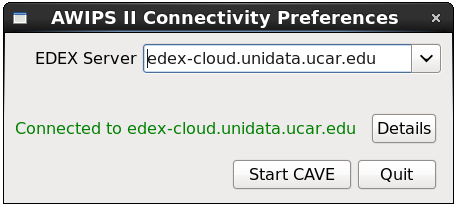5.2 KiB
Download and Install CAVE
Linux
awips_install.sh --caveFor CentOS/Red Hat 6 and 7. Installs to /awips2/cave and writes files to chmod 755 awips_install.shRun CAVE from the Linux Desktop menu Applications > Internet > AWIPS CAVE, or from the command line as simply System Requirements
You can reset CAVE at any time by removing the ~/caveData directory (on macOS ~/Library/caveData) and reconnecting to an EDEX server. |
macOS
Download and install both |
Windows
awips-cave.msiWrites files to ~/caveData (in your user home directory) Requires Python 3, Numpy, and Jep be installed Requires PYTHONHOME be defined In addition to the application directory, the MSI installer will attempt to copy the gridslice shared library to CAVE will still run without gridslice, but certain bundles which use derived parameters, such as isentropic analyses, will not load. |
Windows-Specific Instructions
1) Download and install Miniconda Python 3.7 for Windows
- Allow Miniconda3 to set PATH and other environment variables.
Ensure that PYTHONHOME is set to the Miniconda3 location.

If PYTHONHOME is not set, the gridslice Python module will not be installed or available.
2) Install dependent Python packages
pip install numpy==1.15.1 jep==3.8.2
3) Run awips-cave.msi
AWIPS Data in the Cloud
Unidata and XSEDE Jetstream have partnered to offer a EDEX data server in the cloud, open to the Unidata university community. Select the server in the Connectivity Preferences dialog, or enter edex-cloud.unidata.ucar.edu (without http:// before, or :9581/services after).
caveData Directory
After connecting to an EDEX server, you will have a local directory named caveData which contains files synced from EDEX as well as a client-side cache for data and map resources.
You can reset CAVE by removing the caveData directory and reconnecting to an EDEX server. Your local files have been removed, but if you are re-connecting to an EDEX server you have used before, the remote files will sync again to your local ~/caveData (bundles, colormaps, etc.).
- Linux:
/home/<user>/caveData - macOS:
/Users/<user>/Library/caveData - Windows:
C:\Users\<user>\caveData
